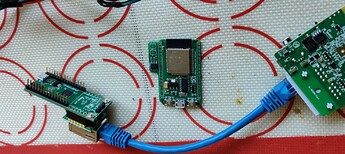Guys, thank you for the warm welcome,
I heard about you from @Sam (thank you Sam  ), and I continued spreading the message by introducing SimpleFOC to Pollen Robotics (my first company). I think they could be interested…
), and I continued spreading the message by introducing SimpleFOC to Pollen Robotics (my first company). I think they could be interested…
@Antun_Skuric world is so small, yes I am interested to share some of your boards to bootstrap the project at least we have to share a coffee and talk.
I will start this week by selecting the easiest MCU to start and compile an open-loop version as runger (I can only mention 2 people per post for now) advised.
I have tons of things on the way so I’m not really sure about how committed I will be, any help is really welcomed.
I will definitely need some help with the motor part.
At Luos we already have users running more than 20 crazy FOC brushless motors in an advanced atomic grade robotic arm. So this is not my first time integrating FOC in a Luos’s service but my first time actually writing code about the motor.
About Luos
To give you more context about the project driving me here. The Idea of Luos is to simplify compatibility between things. To do that we encapsulate a piece of firmware into a package exposing a service. In the SimpleFOC case, this service will be a motor driver (2 services if we have 2 motors).
Services are just a fancy API encapsulating a feature.
Packages are services code folders.
Because services are loosely coupled Packages are independent pieces of code you can easily move from one board to another (a kind of tiny container for embedded systems).
Using the service interface you will be able to send or get the position, speed, torque, trajectory, current, temperature, or anything you want. Luos will allow you to send/receive information from theoretically anything. You can control a collection of motors from any kind of board through a network, or directly using python on your computer, or both at the same time.
We put services into packages to easily share a feature and plan to have a registry soon listing all available packages (a kind of app store). We want SimpleFOC to be one of the first packages.
About the project
To start working on SimpleFOC we plan to add some more context. Currently, we are working on a Test/Demo system able to perform autotest of our library on multiple collaborative devices running a marble circuit. The development of this test system will be publicized on various content explaining how we make it. In the end, users will be able to take control of this system through our website to see any interaction between services (a kind of online remote system debugger).
We plan to create a 3DOF arm to move some marbles. Because the idea of Luos is to make things work together, we planned to create this 3DOF robot with 1 stepper, 1 BLDC, 1DC. We already have the DC and stepper running, and plan to do the BLDC with you. Perhaps this robot will be linked to ROS or Unity, we don’t know yet.
So, step 1: Choose the MCU!

![]() .
.

